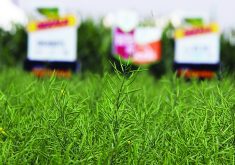SARNIA, Ont. — The creation of an organization representing all of Canada’s sugar beet growers isn’t a top priority for the chair of the Ontario Sugarbeet Growers’ Association.
Mark Lumley said that’s because of the major differences between the Alberta and Ontario industries.
“We’d need to find some synergies there to make it work,” he said.
“It’s almost like we’re growing two different crops.”
Lumley said the main difference is agronomic practices. For instance, Alberta growers need not worry about Cerospora leaf spot, which is a major fungal disease pressure in the East.
Read Also

Farming Smarter receives financial boost from Alberta government for potato research
Farming Smarter near Lethbridge got a boost to its research equipment, thanks to the Alberta government’s increase in funding for research associations.
In addition, beets in Alberta are grown forLantic (Rogers) Sugar, a Canadian company, while Ontario beets are shipped to Michigan Sugar, a farmer-owned co-operative in Michigan. Ontario growers are members of the co-op.
This year, getting paid in U.S. dollars is expected to provide Ontario growers with a decided advantage because of the exchange rate.
Ontario’s sugar beet industry dates back to the late 19th century, but production ended in the province 60 years ago with the rise in cane sugar imports.
The industry was revived in the 1990s when Michigan Sugar, then a private company, came looking to growers in Ontario to boost its acreage. Ontario growers later participated in a farmer-led buyout of the company.
The reemergence of Ontario as a player brought a great deal of new energy to the North American industry, Lumley said.
He believes the province is the leader for piling beets along headlands for pick up. Ontario has the North America dealership for Ropa harvesting and handling equipment, and one farmer has begun manufacturing Big Bear beet carts to transport the roots from self-propelled harvesters to headlands.
“I think we have the highest percentage of self-propelled harvesters in North America,” Lumley said.
“We’ve pretty much Europeanized North America.”
Ontario growers now hope to double their field production to 20,000 acres by embracing new bio-industrial uses such as the production of plastics, jet fuel and ethanol additives.
A $150,000 federal government grant was secured through the National Sciences and Engineering Research Council, and Lumley hopes a pilot plant can be built at Sarnia’s Western University Research Park.
This year’s crop went into the ground by the end of April, which is early, and looks promising, despite excess rain in some areas. Yields of 40 tons per acre were recorded last year.
Fieldman Wayne Martin said Michigan Sugar plans to start its early harvest by Aug. 20 to accommodate what’s expected to be a bumper harvest.
“We feel we have a very good crop coming,” he said. “It’s actually looking as good as last year’s.”
Growers will need to control fungal disease in their fields. Growers began spraying as a preventive measure in the latter half of June.

















